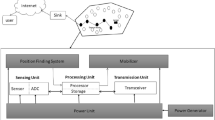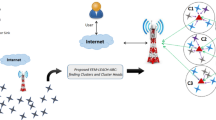Abstract
Wireless sensor network (WSN) seeks an unequal clustering approach to solve its energy hole and HOTSPOT issue. Increasing the cluster number and decreasing the size of the cluster near the sink equally distribute the load across the network. The approach is to made buffer aware to enhance the network lifetime and avoid data packet drop due to buffer overflow. The increase in buffer size is always not possible in preconfigured sensor nodes, making lifetime and data loss as a major problem. An energy-aware buffer management (EABM) routing protocol is designed to overcome the issue. The memory vacancy and energy level are considered before routing the next hop data to the cluster. The proposed EABM routing protocol is compared with LEACH, LEACH-C, ALEACH and EAR routing protocols to support our claim. The proposed routing protocol provides higher lifetime of 1.17 rounds, 1.1 times throughput and 0.73 times reduced packet drop considering LEACH as a benchmark protocol. The energy and buffer filling near the sink are equally distributed in case of the proposed EABM routing protocol.








Similar content being viewed by others
References
Akyildiz IF, Vuran MC (2010) Wireless sensor networks, vol 4. Wiley, London
Rahman A, Anwar S, Pramanik I, Rahman F (2013) A survey on energy efficient routing techniques in wireless sensor networks. In: ICACT, pp 200–205
Chakrabarty K, Iyengar SS, Qi H, Cho E (2002) Grid coverage for surveillance and target location in distributed sensor networks. IEEE Trans Comput 51(12):1448–1453
Du X, Guizani M, Xiao Y, Chen H-H (2007) Two tier secure routing protocol for heterogeneous sensor networks. IEEE Trans Wirel Commun 6(9):3395–3401
Jin S, Li K (2009) LBCS: a load balanced clustering scheme in wireless sensor networks. In: Third International Conference on Multimedia and Ubiquitous Engineering, 2009. MUE’09, pp 221–225
Maheswar, R, “Performance analysis of an energy optimization scheme for cluster based heterogeneous sensor networks”, Anna University Thesis, 2012
Maheswar R, Jayaparvathy R (2010) Performance analysis using contention based queueing model for wireless sensor networks. In: The International Congress for global Science and Technology, pp 59–59
Maheswar R, Jayaparvathy R (2011) Performance analysis of cluster based sensor networks using N-policy M/G/1 queueing model. Eur J Sci Res 58:177–188
Maheswar R, Jayaparvathy R (2012) Performance analysis of fault tolerant node in wireless sensor network. In: Advances in Communication, Network, and Computing: Third International Conference, CNC 2012, Chennai, India, 24–25 Feb, vol 108, pp 121–121
Ghaffari A (2014) An energy efficient routing protocol for wireless sensor networks using a-star algorithm. J Appl Res Technol 12(4):815–822
Mostafaei H, Obaidat MS (2018) Learning automaton-based self-protection algorithm for wireless sensor networks. IET Networks 7(5):353–361
Salehian S, Shamshiri R (2015) A survey on mobility management protocols in wireless sensor network-internet protocol. Indian J Sci Technol 8(11):1
Sasikumar P, Khara S (2012) K-means clustering in wireless sensor networks. In: 2012 Fourth International Conference on Computational Intelligence and Communication Networks (CICN), pp 140–144
Soua R, Minet P (2011) A survey on energy efficient techniques in wireless sensor networks. In: Wireless and Mobile Networking Conference (WMNC), 2011 4th Joint IFIP, pp 1–9
Tandon R, Dey B, Nandi S (2013) Weight based clustering in wireless sensor networks. In: 2013 National Conference on Communications (NCC), pp 1–5
Zhu C, Zheng C, Shu L, Han G (2012) A survey on coverage and connectivity issues in wireless sensor networks. J Netw Comput Appl 35(2):619–632
Yu Y, Estrin D, Govindan R (2001) Geographical and energy-awarerouting: a recursive data dissemination protocol for wirelesssensornetworks. UCLA Computer Science Department Technical Report, UCLA-CSD TR-01-0023, May, 2001
Rodoplu V, Meng TH (1999) Minimum energy mobile wireless networks. IEEE J Sel Areas Commun 17(8):1333–1344
Li L, Halpern JY (2001) Minimum-energy mobile wireless networks revisited. In: Proceedings IEEE ICC’01, Helsinki, Finland, pp 278–283
Kanagachidambaresan GR, Chitra A (2016) TA-FSFT thermal aware fail safe fault tolerant algorithm for wireless body sensor network. Wirel Pers Commun 90(4):1935–1950
Akyildiz IF, Su W, Sankarasubramaniam Y, Cayirci E (2002) Wireless sensor networks: a survey. Comput Netw 38(4):393–422
Kanagachidambaresan GR, SarmaDhulipala VR (2014) Cardiac care assistance using self configured sensor network—a remote patient monitoring system. J Inst Eng India Ser B 95(2):101–106
Kanagachidambaresan GR, SarmaDhulipala VR, Vanusha D, Udhaya MS (2011) Matlab based modeling of body sensor network using ZigBee protocol. CIIT 773–776:2011
Nayak P, Anurag D (2016) A fuzzy logic based clustering algorithm for WSN to extend the network lifetime. IEEE Sens J 16(1):137–144
HodaTaheri et al (2012) An energy-aware distributed clustering protocol in wireless sensor networks using fuzzy logic. Ad Hoc Netw 10:1469–1481
Zhang De-gan, Liu Si, Zhang Ting, Liang Zhao (2017) Novel unequal clustering routing protocol considering energy balancing based on network partition & distance for mobile education. J Netw Comput Appl 88:1–9
Han G, Zhang C, Jiang J, Yang X, Guizani M (2017) Mobile anchor nodes path planning algorithms using network-density-based clustering in wireless sensor networks. J Netw Comput Appl 85:64–75
Muhammed T, Shaikh RA (2017) An analysis of fault detection strategies in wireless sensor networks. J Netw Comput Appl 78:267–287
Yigit M, Cagri Gungor V, Fadel E, Nassef L, Akkari N, Akyildiz IF (2016) Channel-aware routing and priority-aware multi-channel scheduling for WSN-based smart grid applications. J Netw Comput Appl 71:50–58
Ari AAA, Yenke BO, Labraoui N, Damakoa I, Gueroui A (2016) A power efficient cluster-based routing algorithm for wireless sensor networks: Honeybees swarm intelligence based approach. J Netw Comput Appl 69:77–97
Moussaoui O, Ksentini A, Naimi M, Gueroui M (2006) A novel clustering algorithm for efficient energy saving in wireless sensor networks. In: 2006 International Symposium on Computer Networks. IEEE, pp 66–72
Titouna C, Aliouat M, Gueroui M (2016) FDS: fault detection scheme for wireless sensor networks. Wirel Pers Commun 86(2):549–562
Srinivasan K, Dutta P, Tavakoli A, Levis P (2010) An empirical study of low power wireless. ACM Trans Sens Netw (TOSN) 6(2):16
Heidarian F, Schmaltz J, Vaandrager F (2012) Analysis of a clock synchronization protocol for wireless sensor networks. Theor Comput Sci 413(1):87–105
Yao Y, Cao Q, Vasilakos AV (2015) EDAL: an energy-efficient, delay-aware, and lifetime-balancing data collection protocol for heterogeneous wireless sensor networks. IEEE/ACM Trans Netw (TON) 23(3):810–823
Ahmed R, El-Rabaie ESM, Abd-Elnaby M, FathiAbd ES (2013) Efficient routing with compressive sensing for wireless sensor network. INFOCOMP 12(1):1–9
Shekaramiz M et al (2017) Sparse Bayesian learning using variational Bayes inference based on a greedy criterion. In: 51st IEEE Signals, Systems, and Computers (Asilomar) Conference, pp 858–862
Shekaramiz M, Moon TK, Gunther JH (2016) Sparse Bayesian learning boosted by partial erroneous support knowledge. In: 50th IEEE Signals, Systems and Computers, Conference, pp 389–393
Author information
Authors and Affiliations
Corresponding author
Rights and permissions
About this article
Cite this article
Jayarajan, P., Kanagachidambaresan, G.R., Sundararajan, T.V.P. et al. An energy-aware buffer management (EABM) routing protocol for WSN. J Supercomput 76, 4543–4555 (2020). https://doi.org/10.1007/s11227-018-2582-4
Published:
Issue Date:
DOI: https://doi.org/10.1007/s11227-018-2582-4




